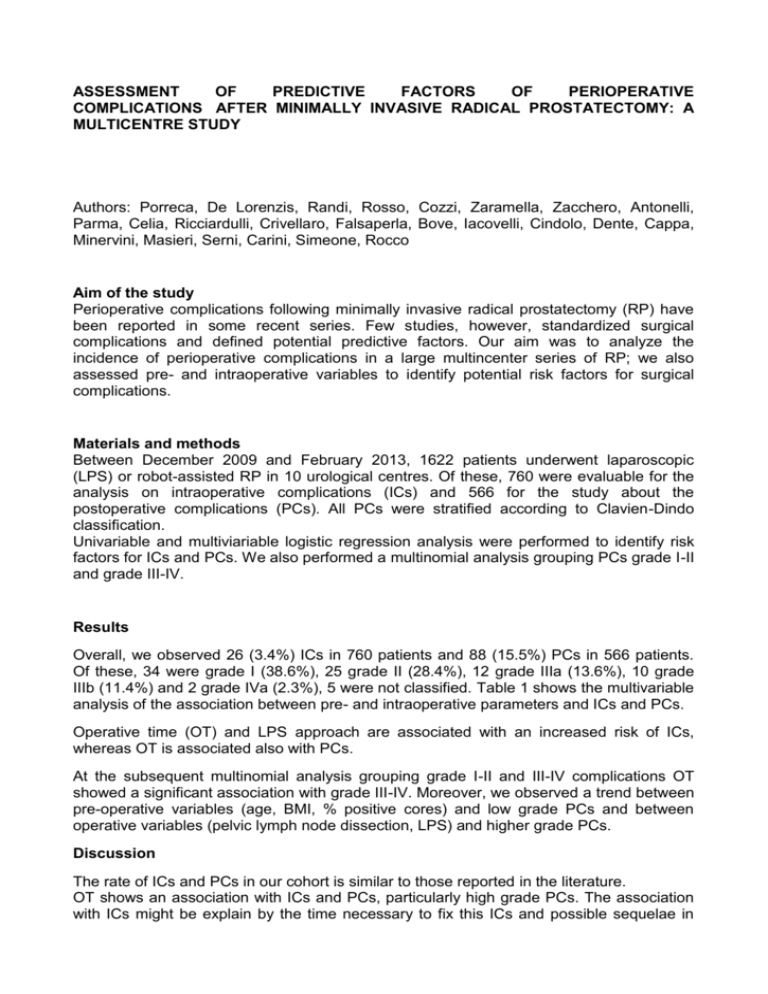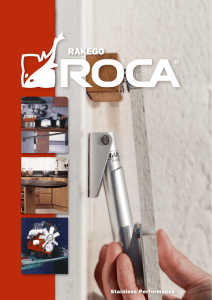assessment of predictive factors of perioperative complications
advertisement

ASSESSMENT OF PREDICTIVE FACTORS OF PERIOPERATIVE COMPLICATIONS AFTER MINIMALLY INVASIVE RADICAL PROSTATECTOMY: A MULTICENTRE STUDY Authors: Porreca, De Lorenzis, Randi, Rosso, Cozzi, Zaramella, Zacchero, Antonelli, Parma, Celia, Ricciardulli, Crivellaro, Falsaperla, Bove, Iacovelli, Cindolo, Dente, Cappa, Minervini, Masieri, Serni, Carini, Simeone, Rocco Aim of the study Perioperative complications following minimally invasive radical prostatectomy (RP) have been reported in some recent series. Few studies, however, standardized surgical complications and defined potential predictive factors. Our aim was to analyze the incidence of perioperative complications in a large multincenter series of RP; we also assessed pre- and intraoperative variables to identify potential risk factors for surgical complications. Materials and methods Between December 2009 and February 2013, 1622 patients underwent laparoscopic (LPS) or robot-assisted RP in 10 urological centres. Of these, 760 were evaluable for the analysis on intraoperative complications (ICs) and 566 for the study about the postoperative complications (PCs). All PCs were stratified according to Clavien-Dindo classification. Univariable and multiviariable logistic regression analysis were performed to identify risk factors for ICs and PCs. We also performed a multinomial analysis grouping PCs grade I-II and grade III-IV. Results Overall, we observed 26 (3.4%) ICs in 760 patients and 88 (15.5%) PCs in 566 patients. Of these, 34 were grade I (38.6%), 25 grade II (28.4%), 12 grade IIIa (13.6%), 10 grade IIIb (11.4%) and 2 grade IVa (2.3%), 5 were not classified. Table 1 shows the multivariable analysis of the association between pre- and intraoperative parameters and ICs and PCs. Operative time (OT) and LPS approach are associated with an increased risk of ICs, whereas OT is associated also with PCs. At the subsequent multinomial analysis grouping grade I-II and III-IV complications OT showed a significant association with grade III-IV. Moreover, we observed a trend between pre-operative variables (age, BMI, % positive cores) and low grade PCs and between operative variables (pelvic lymph node dissection, LPS) and higher grade PCs. Discussion The rate of ICs and PCs in our cohort is similar to those reported in the literature. OT shows an association with ICs and PCs, particularly high grade PCs. The association with ICs might be explain by the time necessary to fix this ICs and possible sequelae in terms of PCs. Robotics seems to have a protective effect on ICs and we can speculate that this is related to its easier surgical interface. Trends toward minor (age, BMI, % positive cores) and major (lymph node dissection and laparoscopy) complications should be investigated prospectively in a larger cohort. Conclusions In our study OT and LPS are significantly associated with higher incidence of ICs; only OT was associated with PCs, particularly high grade. Table 1. Multivariable analysis of the association between pre- and intraoperative parameters and ICs and PCs.* INTRAOPERATIVE COMPLICATIONS (n=26) POSTOPERATIVE COMPLICATIONS (n=88) OR (95% CI) OR (95% CI) 1 1 0.31 (0.14-0.70) 0.89 (0.54-1.48) 1 1 0.62 (0.21-1.86) 1.23 (0.68-2.22) 1 1 1.55 (0.69-3.47) 1.57 (0.96-2.56) 1 1 Surgery procedure Laparoscopic Robot-assisted Percentage of positive cores (%) <25% § >/=25% Pelvic lymph node dissection No Yes Operative time </= 250 minutes§ > 250 minutes 2.50 (1.04-6.02) 1.60 (1.00-2.56) 1 1 1.48 (0.77-2.73) 1.38 (0.74-2.57) 1 1 1.81 (0.81-4.04) 1.44 (0.91-2.28) BMI <26 kg/m2§ >/= 26 kg/m2 Age </= 65 years§ > 65 years * missing data were excluded for each analysis § we calculated this cut-off basing on median value of the variable





